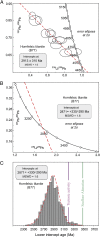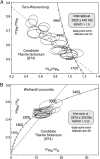Reassessing the biogenicity of Earth's oldest trace fossil with implications for biosignatures in the search for early life
- PMID: 24912193
- PMCID: PMC4060710
- DOI: 10.1073/pnas.1402565111
Reassessing the biogenicity of Earth's oldest trace fossil with implications for biosignatures in the search for early life
Abstract
Microtextures in metavolcanic pillow lavas from the Barberton greenstone belt of South Africa have been argued to represent Earth's oldest trace fossil, preserving evidence for microbial life in the Paleoarchean subseafloor. In this study we present new in situ U-Pb age, metamorphic, and morphological data on these titanite microtextures from fresh drill cores intercepting the type locality. A filamentous microtexture representing a candidate biosignature yields a U-Pb titanite age of 2.819 ± 0.2 Ga. In the same drill core hornfelsic-textured titanite discovered adjacent to a local mafic sill records an indistinguishable U-Pb age of 2.913 ± 0.31 Ga, overlapping with the estimated age of intrusion. Quantitative microscale compositional mapping, combined with chlorite thermodynamic modeling, reveals that the titanite filaments are best developed in relatively low-temperature microdomains of the chlorite matrix. We find that the microtextures exhibit a morphological continuum that bears no similarity to candidate biotextures found in the modern oceanic crust. These new findings indicate that the titanite formed during late Archean ca. 2.9 Ga thermal contact metamorphism and not in an early ca. 3.45 Ga subseafloor environment. We therefore question the syngenicity and biogenicity of these purported trace fossils. It is argued herein that the titanite microtextures are more likely abiotic porphyroblasts of thermal contact metamorphic origin that record late-stage retrograde cooling in the pillow lava country rock. A full characterization of low-temperature metamorphic events and alternative biosignatures in greenstone belt pillow lavas is thus required before candidate traces of life can be confirmed in Archean subseafloor environments.
Keywords: Archean Earth; Archean habitats; astrobiology; bioalteration; ichnofossil.
Conflict of interest statement
The authors declare no conflict of interest.
Figures




References
-
- Furnes H, Banerjee NR, Muehlenbachs K, Staudigel H, de Wit MJ. Early life recorded in Archean pillow lavas. Science. 2004;304(5670):578–581. - PubMed
-
- Furnes H, et al. Comparing petrographic signatures of bioalteration in recent to Mesoarchean pillow lavas: Tracing subsurface life in oceanic igneous rocks. Precam Res. 2007;158(3-4):156–176.
-
- Banerjee NR, Furnes H, Muehlenbachs K, Staudigel H, de Wit MJ. Preservation of ca. 3.4 - 3.5 Ga microbial biomarkers in pillow lavas and hyaloclastites from the Barberton Greenstone Belt, South Africa. Earth Planet Sci Lett. 2006;241(3-4):707–722.
-
- Fliegel D, et al. In situ dating of earth’s oldest trace fossil at 3.34 Ga. Earth Planet Sci Lett. 2010;299(3-4):290–298.
-
- Banerjee NR, et al. Direct dating of Archean microbial ichnofossils. Geology. 2007;35(6):487–490.
Publication types
MeSH terms
Substances
LinkOut - more resources
Full Text Sources
Other Literature Sources

